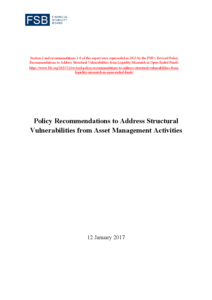This report, responding to a request from the G20, provides an assessment of the evolution of shadow banking activities and risks since the global financial crisis, and the adequacy of post-crisis policies and monitoring to address these risks.
The assessment highlights that the aspects of shadow banking considered to have contributed to the global financial crisis have declined significantly and generally no longer pose financial stability risks.
The report also describes how, since the global financial crisis, policies have been introduced at the international level, and both regulatory reforms and new policy tools have been introduced at national/regional levels to address financial stability risks from shadow banking that have materialised to date:
- Authorities are establishing system-wide oversight and monitoring frameworks to assess the financial stability risks from shadow banking, so that appropriate policy measures can be taken. This includes annual monitoring exercises by the FSB since 2011 to assess global trends and risks in the shadow banking system.
- Authorities have taken steps to address banks’ involvement in shadow banking, including through enhanced consolidation rules for off-balance sheet entities and strengthened bank prudential rules.
- Authorities have acted to reduce liquidity and maturity mismatches, and also leverage in the shadow banking system, including through regulatory reforms of money market funds and recommendations on securities financing transactions.
- National and regional reforms have been undertaken to address incentive problems and opaqueness associated with securitisation, alongside increases in capitalisation of banks’ securitisation-related exposures.
However, a rise in assets held in certain investment funds has increased the risks from liquidity transformation. These developments underscore the importance of effective operationalisation and implementation of the FSB’s January 2017 policy recommendations to address structural vulnerabilities from asset management activities.
At present, the FSB has not identified other new financial stability risks from shadow banking that would warrant additional regulatory action at the global level. However, since shadow banking evolves over time, authorities should continue to vigilantly monitor and address emerging financial stability risks, and keep up to date the regulatory perimeter.
To these ends FSB member authorities have agreed on the following recommendations:
-
Enhance system-wide oversight of shadow banking and policy responses to address the identified risks by: (i) establishing a systematic process for assessing financial stability risks from shadow banking, and ensuring that any entities or activities that could pose material financial stability risks are brought within the regulatory perimeter; (ii) addressing identified gaps in risk-related data; and (iii) removing impediments to cooperation and information-sharing between authorities.
-
Strengthen the monitoring of shadow banking activity and data collection. The FSB will assess the data availability and make improvements to its annual monitoring exercise as appropriate in 2018.
-
Complete the remaining policy development at the international level and implement the agreed policy recommendations to reduce risks and arbitrage opportunities across jurisdictions and sectors. In this regard, it is important that: (i) the Basel Committee on Banking Supervision completes its guidelines on step-in risk; (ii) the International Organization of Securities Commissions operationalise the FSB recommendations to address structural vulnerabilities from asset management activities in line with the agreed timeline; and (iii) national/regional authorities implement agreed policy recommendations in a timely and consistent manner.
